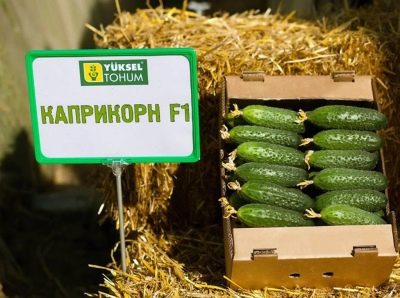
- Authors: Yuksel, Turkish selection
- Growth type: vigorous
- Fruit weight, g: 120-140
- Fruit length, cm: 12-14
- Fruit color: deep green with light stripes
- Ripening terms: ultra early
- Fruit shape: elongated, cylindrical
- Fruit taste: no bitterness
- Scent: fragrant
- Appointment: for pickling and preserving, for fresh consumption
Most summer residents and farmers prefer to grow early types of cucumbers, which quickly adapt to growing conditions, bear fruit stably, without requiring intensive care. One of these is the ultra-early hybrid Capricorn, Turkish selection.
Breeding history
The Capricorn cucumbers are the result of the work of Turkish breeders of the Yuksel Seeds seed company, whose main task was to create a vegetable crop with stable fruiting, which can be grown both in a garden bed and in all types of greenhouse structures. You can grow a Turkish hybrid in different climatic zones. The crop that grows in the greenhouse is the most productive, but you can also get an excellent harvest in the beds.
Description of the variety
Vegetable culture Capricorn is a vigorous bush with a powerful central stem, growing in height up to 1.5-2 meters, weak thickening with medium and small leaves of bright green color, shortened internodes and medium-sized lateral shoots. The species is parthenocarpic, therefore, it does not need additional pollination by bees.
During the flowering period, large yellow flowers form on the bushes. Flowering in a female type plant. It is characteristic that empty flowers practically do not appear. Up to 5 zelents are formed in each bundle.
Characteristics of the appearance of plants and zelents
Cucumbers are endowed with high commercial qualities. On a healthy bush, fruits ripen, weighing 120-140 grams and up to 14 cm long. Cucumbers grow neat, leveled. The shape of the zelents is elongated or cylindrical. Ripe cucumbers are evenly covered with bright green color, diluted with light stripes. Fruit rind of moderate density, covered with large tubercles and white thorns.
The harvested crop can be easily transported, and can also be stored for a long time in a cool place. Experienced farmers recommend removing cucumbers up to 7-9 cm long.
Purpose and taste of fruits
Zelentsy Capricorn are famous for their excellent taste. The flesh of vegetables is dense, fleshy, tender, juicy, very crunchy, without wateriness and voids. The taste is pleasant, slightly sweet, without bitterness, complemented by a refreshing aroma. A feature of the variety is the absence of seeds in the pulp. In addition, the peel is not felt at all when eaten.
Ripe greens can be eaten fresh, added to salads and various vegetable cuts, canned, pickled and salted.
Maturation
The hybrid belongs to the ultra-early class. From the moment of the emergence of mass shoots to the ripening of zelents, only 32-35 days pass. Cucumbers spice together. The maximum yield of the crop falls on the first month of fruiting. It is recommended to choose greens every other day, otherwise overripe vegetables lose their shape and taste. You can taste cucumbers at the end of June, and a massive collection of vegetables occurs in July.
Yield
The yield indicators for this species are good.Observing all agrotechnical recommendations, about 3 kg of crispy cucumbers can be removed from 1 bush. In a greenhouse, the yield is higher - up to 5-6 kg of fruits from each bush.
Landing scheme
Maintaining the distance between plantings is very important when planting a crop. It is recommended to place 2-3 cucumber bushes per 1 m2. The correct layout for planting is 70 / 90x30 cm.
Growing and care
The Turkish hybrid is grown primarily through seedlings. This requires strengthened bushes with a height of 20-25 cm, with 3-5 true leaves and a developed rhizome. You can plant seedlings in a greenhouse in the second half of May, and on a garden bed in early June. The best place to plant will be an area where potatoes, tomatoes and cabbage were previously grown.
Intensive agricultural technology consists of standard measures - irrigation with settled or warm water 1-2 times a week, the introduction of organic and mineral fertilizers (2-3 times during the growing season), weeding and furrowing of the soil, the formation of a bush in 1 stem and a garter, pinching the stem, thinning (removing unnecessary stepchildren), prevention of diseases and pest infestations. Greenhouses require regular ventilation.
Soil requirements
The plant has no special requirements for the soil, but it is comfortable for cucumbers to grow in loose, nutritious, breathable and non-acidic soils. As practice shows, a vegetable crop can also grow in heavy soils. The occurrence of groundwater must be deep.

In order to collect strong, tasty and beautiful cucumbers on your site, you need to make top dressing. Lack of nutrients can negatively affect the appearance of the plant and significantly reduce the yield. Fertilize cucumbers with organic fertilizers in combination with mineral fertilizers. With the right balance of these components and adherence to the fertilizing schedule, the cucumber yield will be maximum.
Required climatic conditions
The Turkish hybrid is a rather thermophilic plant, therefore it reacts negatively to temperature drops below + 14-15 degrees. In addition, cucumbers are drought tolerant, heat tolerant, but have a negative perception of prolonged shade.
Disease and pest resistance
The Turkish hybrid has strong immunity, therefore it is able to withstand many diseases - the cucumber mosaic virus, root rot, powdery and downy mildew.

Despite their popularity, cucumbers are often attacked by diseases and pests. From them, cucumber plantings often die before the start of fruiting. In order to prevent this from happening, it is necessary to try to prevent ailments or get rid of them at the very beginning, having studied in detail their causes of occurrence, signs and methods of treatment.





























































































